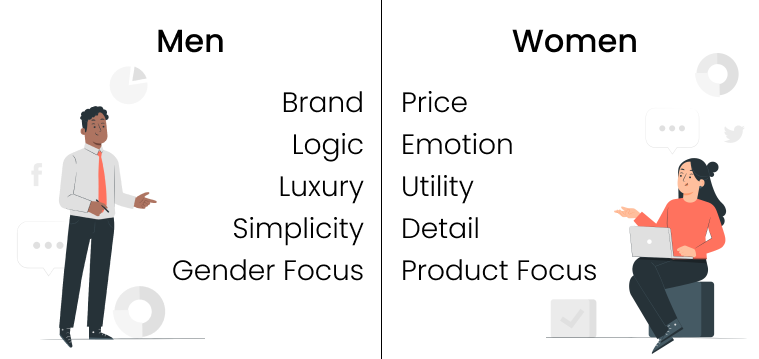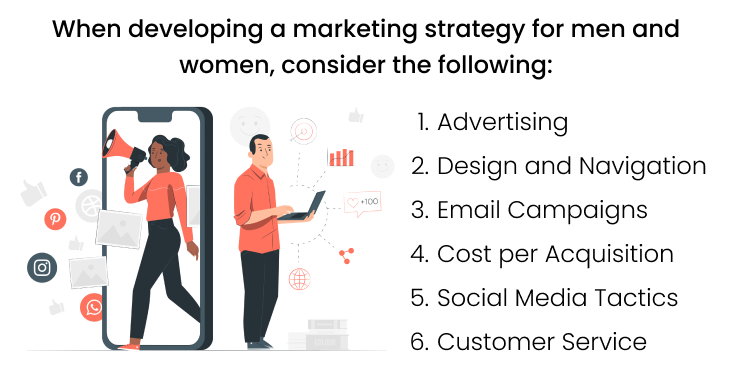Over the past couple of years, there have been many studies on the fundamental gender differences carried out to find out the peculiarities of marketing to men vs women. As a result, marketers search for the perfect strategy for both: men and women.
Meanwhile, men and women demand equality in everything, from job positions to household duties, and rightfully so. Yet, marketers search for the perfect strategy, for a formula that will give the targeted audience exactly what they want, regardless of man or woman. An impossible task, some might argue, so let’s dive into such an interesting topic.
Eternal Gender Issue
Despite all stereotypes, we should voice some facts - both men and women are equally capable of intellectual performance. Yet, the fundamental difference lies in the way each gender processes the information. However, everyone, regardless of gender, wants to get an excellent quality-price ratio.
Currently, the gender lines are starting to blur heavily as marketing to men vs women requires valuable data to develop a diverse, compelling strategy. Following specific stereotypes, as was previously the case, can lead to disastrous results.
Back in the day, scientists assumed that women adored graphics and storytelling. That remains true, but it also extends to men. The game is now in the way one can word the message, as well as how much you can expose the same ad to a single individual.
For example, it takes more impressions and softer words to converse with a woman buyer, whereas men require fewer exposures but bold claims to make the purchase. The reason for such behavior is that women’s brains are mostly dedicated to verbal communication, as women often speak around 20 000 words per day. In contrast, men usually tend to speak only 7 000 words.
While marketing to a male audience, typically, sales reps consider that they are more compulsive and result-driven. In turn, women want more details and emotional messages and care a lot about what others think.
This emotion is no small part of how a woman’s brain works. A woman’s memory is associated with emotions, whereas men are designed to solve problems with as few steps as possible. It is all scientific, but we need practice and results.
What is Gender Marketing?
Gender marketing is a type of marketing strategy that is based on gender division by males and females. Even more, it considers the integration of gender stereotypes into the advertising strategy. Sure, we are living in the 21st century, where gender roles are getting blurred. Still, due to society and cultural influence, we should also know how to develop a gender marketing strategy.
For example, if you think of how to attract female customers, you are supposed to know their common behavioral features and their interest areas. Therefore, you will have the opportunity to provide a better customer experience.
In this article, we analyze the traditional path of marketing, but we also should point out there are also other modern methods. Therefore, when designing your marketing tactics, pay close attention that both men and women are looking for facts and data. We live in a different age, where you can access information in just about any place at any time in whatever capacity you want.
So, let’s delve deeper into the traditional marketing approach.
Marketing to Men vs Women: Peek into Demands
When devising your marketing strategy for both sexes, you need to know what exactly your service or product can scratch in each gender. You need to know what can appeal to men and what can pursue a woman. Check out the following information:

Brand vs Price
Caring about their time, men prefer to buy brands or well-known products without paying much attention to the cost. In the meantime, women are considered real hunters - they compare various offers and aim to get the same (or comparable) product for a lower price.
Logic vs Emotion
Emotions and tactile experience play a larger role in the decision-making process for women. On the other hand, males need fewer details and fewer steps and often demand a clear description and functionality guide if the product/service is complicated.
Luxury vs Utility
When marketing to men and women, remember that men are operating on a “must-have” basis in that they are ready to pay a solid amount if the item is desired. Women are “deal seekers” who look for practicality and low to moderate pricing.
Simplicity vs Detail
Generally, men prefer clear guidelines and solutions requiring less effort to converse. At the same time, women prefer loads of details, descriptions, and comparisons as they deem such information credible and worthwhile.
Male vs Female
In the male vs female advertising strategy, the gender of the product is obvious but important to mention. Men are indeed attracted to products and services that are marketed as for males, therefore, functional and problem-solving. However, women focus on the efficiency and utility of the product and give no attention to gender because a result is more valuable.
6 Things to Consider When Developing a Strategy in Marketing to Men vs Women
Before kicking off your strategy development process, you need to understand that marketing to men vs women is possible but complicated.
Both genders have specific habits and preferences you must take into account. Knowing these nuances will allow you to create the right message at the right place, which leads us to the tips themselves.

#1 Advertising
When creating your ad campaign, remember that men require direct and instructional messages, suggestive humor, and competitive activities. Answering the question of how to market to women, they are susceptible to visuals and emotional content connected to real-life activities. Furthermore, your ads must feature relatable situations; otherwise, you will miss the traffic.
#2 Design and Navigation
To explain the difference in marketing to men vs women, let’s take your website as an example.
For a male audience, the ideal funnel looks like this - once the client comes, you can route him to the desired destination by showing key elements and simple navigation. In order to convert a female visitor, navigation should be intuitive and filled with details. Women aren’t as trusting of info on websites as men, so make sure your copy is compelling.
#3 Email Campaigns
Men prefer to surf the web for a solution to their issues, and emails aren’t effective in reaching them as you might think. Yet, women value a personal approach and pay considerable attention to their inboxes. This means newsletters will perform better with a female audience than with a male audience.
#4 Cost per Acquisition
It is worth pointing out that it is hard to convince men to buy something new and unknown to them. This can be related to the meaning of marketing to women as well. However, they buy items more often. This observation suggests that men are naturally loyalists, whereas women like to try out new products.
#5 Social Media Tactics
Marketing to men vs women in social networks can be tricky. The female audience checks out brands and companies’ accounts more often. They seek shared experiences and strive for outside influence to make decisions. Men hate scrolling their news feeds and make decisions based on intuition and deduction.
#6 Customer Service
When planning your marketing strategy, don’t forget about customer service policies. Work out numerous ways to present problem-solving instructions. If men have issues, they will most likely ask for precise directions. Women, in their turn, will let you know if they have problems or require more details and would be happy to hear a more detailed answer.
Bonus Tips to Consider
While the tips above are fundamental, knowing the following ones will prove helpful in one way or another.
Shopping Experiences
There is a considerable difference in how men and women perceive a good shopping experience. There are many ways to market to women as they enjoy face-to-face communication, whereas men prefer good parking accessibility and store inventory. This means that if you have many products designed for males, it might be useful for you to highlight availability. Women, on the other hand, will prefer sales staffs that are courteous and knowledgeable.
Decisions
The way men and women think about products and the path before they purchase them is a night and day difference. Women gather as much data as they can, form an entire picture and only then make the conversion. Men, on the other hand, tend to eliminate competition first. They decide on a specific feature or a certain quality a product must have, and if some options don’t have that attribute, they are out of the equation. This narrows down the list and, ultimately, makes the decision process faster.
Process & Outcome
If you don’t know how to market to men, another thing you should take is that they think about the outcome first. While buying a product, they don’t think about the process but rather the result. In other words, if a male student goes to the university, he thinks about what kind of job he’ll be able to get at the end, whereas women like the idea of the process, what they’ll learn, and what connections they’ll make. In that sense, you can tailor your marketing message to meet the demands of a specific gender more effectively.
Who Does the Shopping
Despite not being detrimental to your marketing campaign, women often purchase more products. This means they are more often out shopping or doing online shopping, and therefore, they are making decisions more often. However, men make more expensive purchases than women. Therefore, depending on your product or service, consider this info first and create the rest of your campaign to make the customer journey smooth.
Closing Thoughts
To succeed in marketing to both men and women, your product or service should present the idea and outcome to meet the needs of a male audience, as well as have the option to show the story behind the product to your female customers. We know that it can be challenging, but putting time and effort into it is worth trying.








